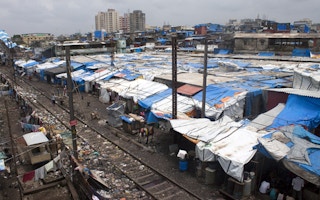By 2025, with urbanisation racing ahead, China will have at least 220 cities of more than a million people, and India will have at least 68, urban experts predict.
How will Asian and African cities already struggling with overflowing slums and shortfalls of everything from sewer systems to bus transport cope as millions of new arrivals pour in?
The key is planning ahead, preparing for the new arrivals and consulting them – and the vulnerable people already living in cities – about what they need most to make their lives easier, said urban specialists at the recent Skoll World Forum on Social Entrepreneurship.
“
Cities need to create an “enabling environment” for migration, otherwise “in the absence of that you have an exacerbation of the problems” cities already face
Joel Bolnick, secretariat coordinator for Slum Dwellers International
Cities need to create an “enabling environment” for migration, otherwise “in the absence of that you have an exacerbation of the problems” cities already face, said Joel Bolnick, secretariat coordinator for Slum Dwellers International, a global network of organisations for the urban poor.
Brazil’s efforts in recent decades to turn “favela” slums into integrated parts of the city shows what’s possible. By simple actions like providing bus services into the favelas and dramatically reducing travel times, cities such as Sao Paulo and Rio de Janeiro have made it much easier for slum dwellers to travel to work.
That has raised incomes, reduced poverty and cut the amount of time children are left alone at home, said Doug Saunders, a journalist and the author of Arrival City, a book on rural-urban migration.
City officials and experts “can’t make (slum dwellers) less poor, but we can remove barriers to them making themselves less poor,” he said.
Allocating land and giving slum dwellers and new migrants titles for their homes can also improve lives. In particular, “in Africa, the difference between squalid and better slums is land ownership,” Saunders said.
Consultation
While building health services and schools and planning sewer and water services in slums are important, the most critical aspect of ensuring the right things are in place for slum dwellers and new migrants is consulting them on what they need.
Often “solutions imposed from outside have failed. You can’t just have poor people take over what other people have delivered.” said Bolnick of the slum dwellers association.
His organisation, for instance, has helped slum dwellers organise women’s savings networks in 550 cities in 55 countries. With start-up cash in hand, women then go to government officials to talk about what infrastructure changes or programmes they need, and offer start-up funds for the government to match.
“When they sit down with the government they are not empty handed,” he said. “They say, ‘This is what we’re putting on the table. What are you putting on the table?’”
The effect of such efforts is that slum dwellers have an investment in projects – ones they asked for, need and are much more likely to work hard to keep going.
Impacts of climate change
Such consultation will be particularly important as cities face worsening impacts from climate change, including more severe flooding which disproportionately affects slums and other areas where new arrivals tend to settle.
Jockin Arputham, president of Slum Dwellers International and a community organiser in India for 40 years, said slum dwellers in Mumbai have mapped water levels during flooding periods in an effort to chart the areas most at risk.
Slum dwellers also are responding to increasingly extreme summer heat by removing exterior walls from the second storeys of some slum buildings, to try to improve air flow, he said.
“Ordinary people don’t know anything about climate change. That is the middle class talking,” he said. “But the poor know about the heat and the monsoon.”
Increasing rural-urban migration is creating problems in cities – but also promises many benefits, the city experts said.
Agricultural productivity, for instance, increases when fewer people are in rural areas and plot sizes increase, Saunders said. Health and education – particularly for girls – also improves in urban settings, and family sizes become much smaller among urban dwellers “regardless of culture or circumstances”.
Iran, for instance, saw the average number of children born per family fall from 7 in the 1980s to 1.7 now as it urbanised, he said.
But in too many places, migration is still looked on as something that needs to be curbed. Slums – the arrival destination for many migrants – are thought of as places that need to be eliminated in order to upgrade cities, Bolnick said. For international development agencies, he charged, “upgrading of slums and the creation of inclusive cities is hardly on the agenda.”










